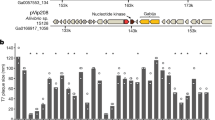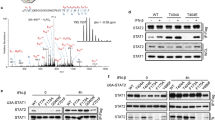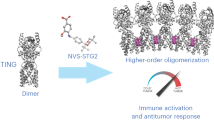Abstract
IN spite of various theories, the mechanism of the antiviral action of interferon1–3 remains obscure. Previous work indicated that it does not have to penetrate into target cells to exert its effect. Mouse interferon preparations, when covalently bound to Sepharose beads, retained full antiviral activity, even after multiple cell-to-cell transfers4. Physical restriction of Sepharose-bound interferon to a well defined area on the cell monolayer protected only cells in immediate contact with the insoluble interferon preparation, but not those unable to make such contacts. This excluded the possibility that soluble interferon diffused from the Sepharose beads to which it was attached5. If indeed interferon induces its antiviral effect by interaction with the cell surface, interferon-sensitive cells should possess specific receptor sites. We report here the inhibitory action of certain plant lectins on the action of interferon.
This is a preview of subscription content, access via your institution
Access options
Subscribe to this journal
Receive 51 print issues and online access
$199.00 per year
only $3.90 per issue
Buy this article
- Purchase on Springer Link
- Instant access to full article PDF
Prices may be subject to local taxes which are calculated during checkout
Similar content being viewed by others
References
Isaacs, A., and Lindenmann, J., Proc. R. Soc. London, B 147, 258–267 (1957).
Isaacs, A., Cox, R. A., and Rotem, Z., Lancet, ii, 113–116 (1963).
Grossberg, S. E., New Engl. J. Med., 287, 1–19 (1972).
Ankel, H., Chany, C., Galliot, B., Chevalier, M. J., and Robert, M., Proc. natn. Acad. Sci U.S.A., 70, 2360–2363 (1973).
Chany, C., Ankel, H., Galliot, B., Chevalier, M. J., and Gregoire, A., Proc. Soc. exp. Biol. Med. (in the press).
Craighead, J. E., and Shelokov, A., Proc. Soc. exp. Biol. Med., 108, 823–826 (1961).
Lowry, O. H., Rosebrough, N. J., Farr, A. L., and Randall, R. J., J. biol. Chem., 193, 265–275 (1951).
Ahmed, A. I., Osuga, D. T., and Feeney, R. E., J. biol. Chem., 248, 8524 (1973).
Sage, H. J., and Green, R. W., in Methods in Enzymology (edit by Ginsburg, V.), 28, 332–339 (1972).
Osawa, T., and Matsumotu, I., in Methods in Enzymology (edit by Ginsburg, V.), 28, 323–327 (1972).
Bourgeade, M. F., and Besancon, F., C. hebd. Seanc., Paris, 277, 2833–2835 (1973).
Dorner, F., and Scriba, M., and Weil, R., Proc. natn. Acad. Sci. U.S.A., 70, 1981–1985 (1973).
Cuatrecasas, P., Proc. natn. Acad. Sci. U.S.A., 63, 450–451 (1969).
Cuatrecasas, P., J. biol. Chem., 248, 3528–3534 (1973).
Author information
Authors and Affiliations
Rights and permissions
About this article
Cite this article
BESANCON, F., ANKEL, H. Inhibition of interferon action by plant lectins. Nature 250, 784–786 (1974). https://doi.org/10.1038/250784a0
Received:
Revised:
Issue Date:
DOI: https://doi.org/10.1038/250784a0
This article is cited by
-
Purification of Two Novel Sugar Acid-binding Lectins from Haplomitrium Mnioides (bryophyte, Plantae) and their Preliminary Characterization
Applied Biochemistry and Biotechnology (2017)
-
Inhibition of murine L cell interferon action by heparin
Archives of Virology (1986)
-
Interferon induces an antiviral state in ganglioside-deficient transformed mouse fibroblasts
Medical Microbiology and Immunology (1981)
-
The role of interferon in viral infections
Springer Seminars in Immunopathology (1979)
-
Specificity and reversibility of interferon ganglioside interaction
Nature (1976)
Comments
By submitting a comment you agree to abide by our Terms and Community Guidelines. If you find something abusive or that does not comply with our terms or guidelines please flag it as inappropriate.



